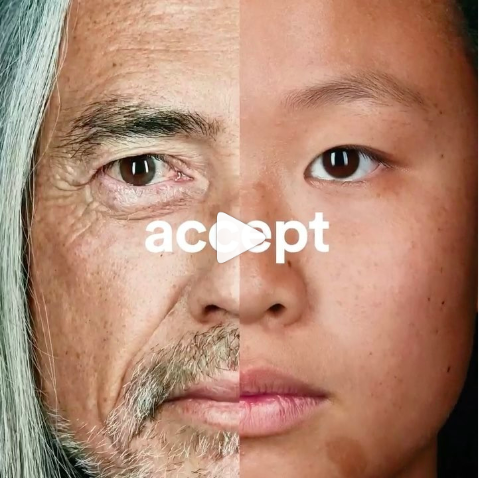Note: Scroll to the bottom for the infographic of this article.
We’ve all seen one of those ads that just hits the ground running and before you know it, it’s “gone viral”. It almost doesn’t even matter what the subject is; all sorts of people outside the brand’s demographic will watch it, like it and share it – because a great ad is a great ad. Period.
Remember the “Alexa Loses Her Voice” video ad during the 2018 Super Bowl? After Amazon’s virtual digital assistant loses her voice, the company tries to get a substitute voice – with hilarious results. Not only was the one-and-a-half-minute ad that year’s most-viewed video ad on YouTube with 50 million views, but it won USA Today’s 30th Ad Meter award.
Although ads that go viral may seem to be random (much like you can’t always predict which song will hit the Top 40 or which movie will win an Academy Award) there is actually more thought and planning behind it than you know. Amazon’s creative director explained that he chose celebrities – Gordon Ramsey, Cardi B, Rebel Wilson and Anthony Hopkins – who appealed to people of various ages and demographics. In addition, the content of the advertisement was very relevant, very current and very entertaining.
Viral marketing gives marketers a tremendous opportunity to earn quick publicity and grow their business and this list article will go through 26 points (A to Z) that comprise viral content.
What Is Viral Marketing?
Sometimes referred to as viral advertising,
“Viral marketing is a business strategy that uses existing social networks to promote a product. Its name refers to how consumers spread information about a product with other people in their social networks, much in the same way that a virus spreads from one person to another. It can be delivered by word of mouth or enhanced by the network effects of the Internet and mobile networks.”
This type of content is termed “viral” because of the pace at which it spreads, and it couldn’t exist without the growth and prevalence of social media. If we come across something that’s out of this world, we love sharing it with our friends and colleagues. That’s the philosophy behind creating viral content: you have to make it share-worthy.
The A-to-Z of Viral Marketing
Let’s now look at the A-to-Z of viral marketing and how your business can benefit from it (scroll down for the infographic version of this):
A) Attention Grabbing
Most Internet audiences are busy. They’re short on time, not to mention attention span. Your viral content should grab attention immediately, rather than creating a slow build. It needs to be something that people will notice when they’re busy and then stop everything to watch.
B) Buzzworthy
Viral marketing can help you create a quick buzz about a new or an existing product or service, like Gillette’s ad for their razors – and toxic masculinity – that got people talking. Even if you’re a small business or a startup, you can still get the immediate visibility of a larger brand if your content goes viral.
C) Crazy Idea
When you look at Dollar Shave Club’s video ad called “Our Blades Are F***ing Great,” you have to wonder how a crazy video (or at least title) like that ever got ideated and executed. (By the way, not that we’re pushing razor ads. 😉 )
The video shows the founder of a razor company talking about their subscription service that costs just one dollar a month. He makes it super funny by telling you that when you spend $20 buying branded razors, $19 of that go to Roger Federer! The video got a whopping 26M views, helping the razor startup skyrocket to success.
D) Different Message
Viral marketing messages and experiences are unusual and unpredictable. They are non-conformist. Viral content needs to talk about something new, as in the Alexa video in the intro (who else was talking about a digital assistant losing its voice?) or the DSC video above (who else was talking about razors? Aside from Gillette…).
E) Emotional
We all watch a host of videos on social media, but we enjoy content that appeals to us in an emotional way the most, whether that emotion is laughter or sadness. As digital marketer Joydeep Bhattacharya reminds us, “When there are sufficient details and authentic emotions in the tale, the listener or reader is able to connect to a story easily – and brands can use this device to make people understand how their products add value to their lives.”
Real Beauty Sketches, a video ad from Dove, “explores the gap between how others perceive us and how we perceive ourselves. Each woman is the subject of two portraits drawn by FBI-trained forensic artist Gil Zamora: one based on her own description, and the other using a stranger’s observations. The results are surprising….”
As Susan Wojcicki, CEO of YouTube, said: “These video ads don’t just generate impressions, they leave impressions.”
Dive Deeper: 7 Examples of Storytelling Content You Can Use in Your Marketing Campaigns
F) Failure
A viral stunt or a social media campaign has a high probability of failing, so you must be careful that it doesn’t cross any boundaries. For example, the car brand Hyundai was forced to pull their video ad of a man unsuccessfully attempting to commit suicide with exhaust fumes from one of their vehicles: “The ill-conceived punch-line was that the SUV, an iX35, runs on hydrogen and, therefore, emits only water vapor, so the man can’t kill himself.”
The very nature of viral content – attention-grabbing, crazy, buzzworthy – is that you might wind up going over the line of what people find acceptable and have to issue a public apology. Prevent this from happening by getting multiple and diverse opinions and feedback (that means women, people of color, folks with disabilities, seniors, Millennials, etc.) from your team before you launch your ad.
G) Gather Data
While planning a successful viral marketing campaign, you need to first understand your audience. You must create a buyer persona to really know your target audience’s demographics such as age, location and profession, as well as psychographics like interests, hobbies, personal preferences, and online activity:
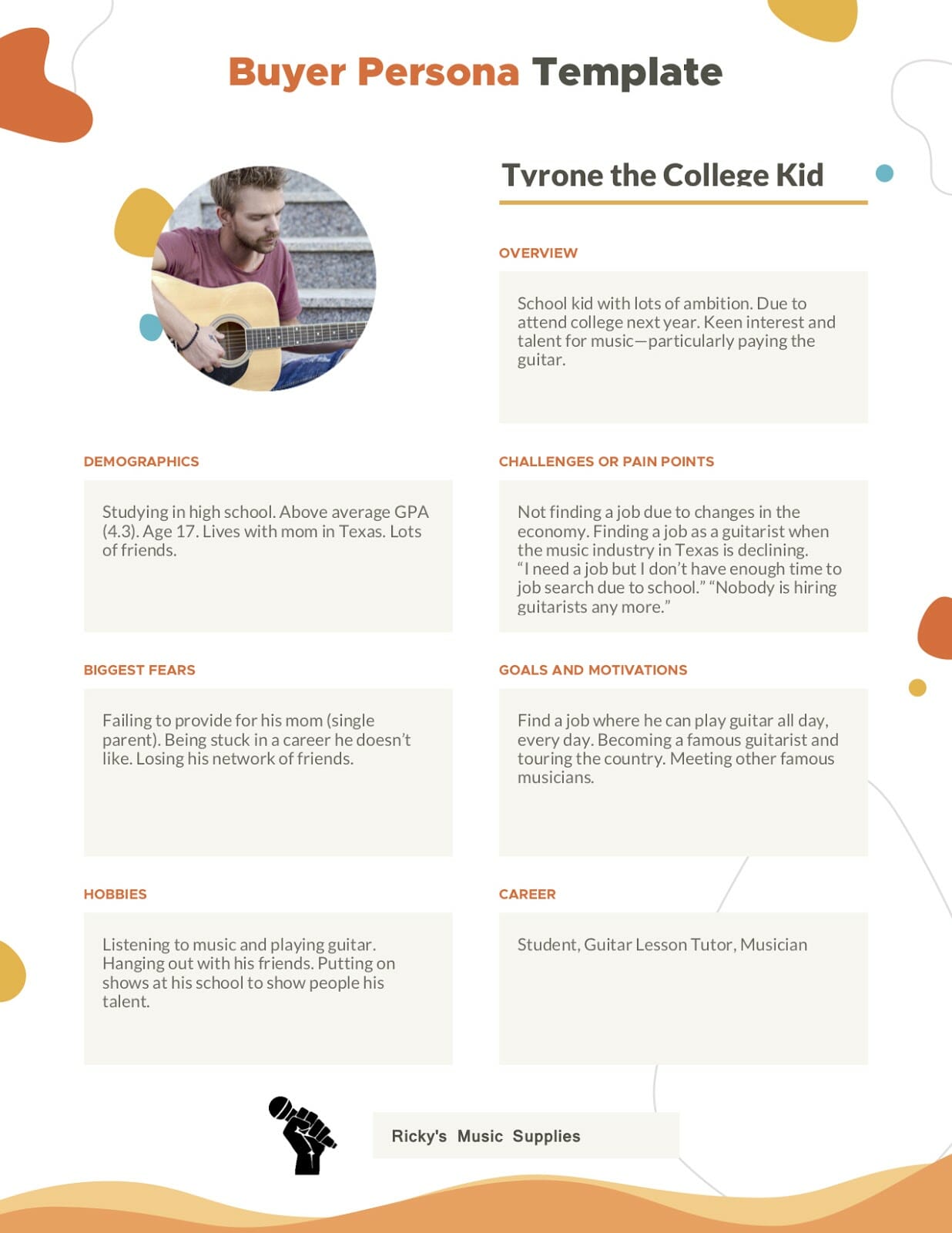
You also need to know the social media platforms they prefer to use. It’s critical to analyze viral campaigns in your industry and decide on your preferred social media channel.
For example, Old Spice’s “The Man Your Man Could Smell Like” viral campaign was based on a study that 70% of shower gel for men was purchased by women in their household. With that (surprising?) info, they created an ad for a man’s product that was marketed to women. This type of data will help you to create an effective viral marketing idea that no one else is privy to.
Dive Deeper: The Ultimate Guide to Developing Buyer Personas (with Templates!)
H) Headline
The first thing that a user comes across when they look at a piece of content is its headline. In fact, that may be the only thing they read: About 80% of people will read your headline, but only 20% will read the rest of your content.
If you have an intriguing, informative title that squeezes in the benefits the reader will receive after reading or watching your content, then you’re off to a flying start. Take a look at this headline from a blog post that went viral when at least a million people read it: “How to Quit Your Job, Move to Paradise and Get Paid to Change the World”.
To learn the formulas that make the best title for your blog post, video or ad, check out How to Write Hero Headlines to Skyrocket Click-Through Rates.
I) Interactivity
A viral campaign must inspire your audience and get them involved, and interactive content can do just this. The Geek’s Guide to London, an animated infographic that recommends places in London to visit, or Single Grain’s Marketing ROI Calculator, an online tool that calculates how much money you’re make with marketing, are two such examples.
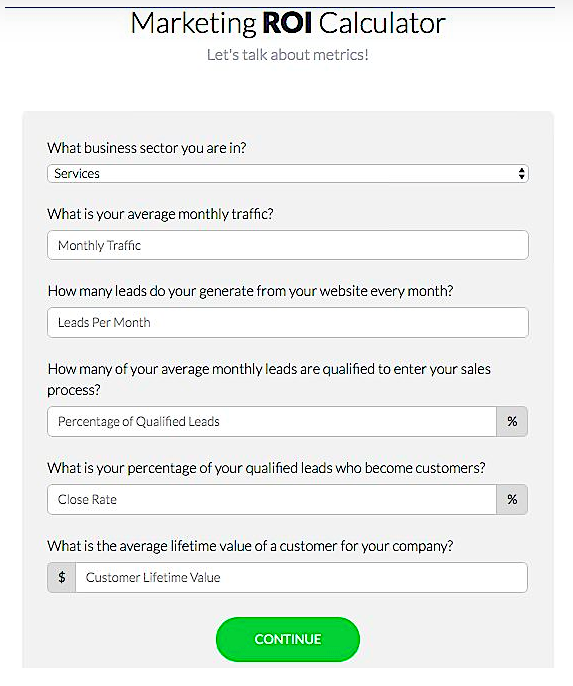
With practical, easy-to-use and fun content, it’s much more likely that people will share and rave about it.
Dive Deeper: 7 Types of Interactive Content—Why & How to Use Them
J) Journey of Your Viral Campaign
You need to know the journey of your viral campaign from start to end, so it’s essential to have a plan-of-action that ensures that your campaign message flashes at each customer touch-point. You’ll need to figure out your key performance indicators (KPIs) so that you can actually measure the performance (how can you determine results if you don’t know what you’re measuring?).
Tip: When your message starts to get some shares, you can talk about it on the homepage of your website, blog, social media channels, etc. You can then send it out to the press for additional coverage.
Dive Deeper: What Gets Measured Gets Managed: How to Use Metrics to Boost Performance
K) Killer Idea
If something sounds exciting as an idea and you think your audience would love it, then you’re on the right track. In simple terms:
A killer idea = a relatable story + your USP
Your idea could be presented in any format – video, image, etc. – as long as it leaps out at your audience and entertains them or makes them think. Take a look at these two examples, both of which happen to be photos.
With over 53.9 million likes, more than 3 million comments and 10 million subscribers, “The Egg” is an example of one of the “simplest and craziest marketing stunts of 2019”. The post appeared on Instagram with the goal of beating the previous record-breaking post (belonging to Kylie Jenner), which it did:

Another example is KFC’s apology post went viral by “openly admitting their shortcoming and echoing the sentiments of its patrons.” It was a response to the “chicken shortage” in their London stores – 900 KFC outlets were shut down because they ran out of chicken and people were upset.
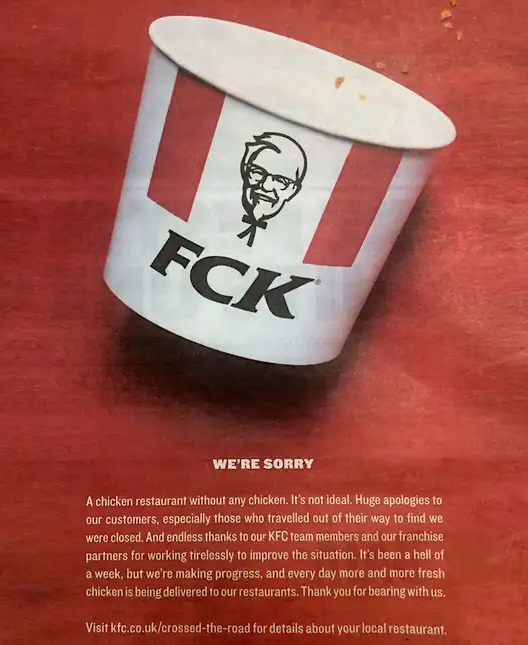
L) Laughter
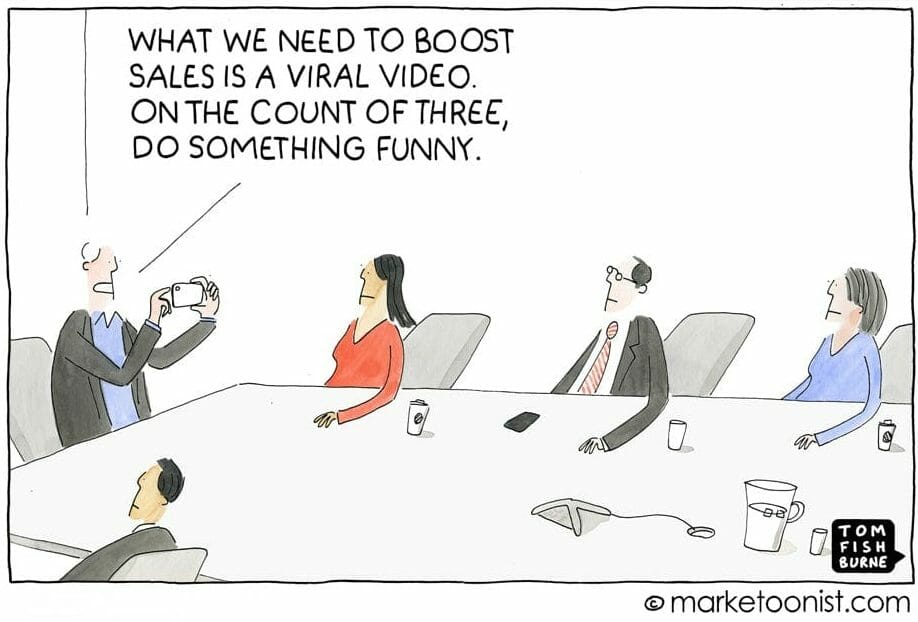
Most viral campaigns tend to use humor, as that’s the surest way to connect with people. Even if your product or service is not funny, you can still make your audience laugh with a funny character (like the Dollar Shave Club founder), using a comedy writer or hiring a funny actor or comedian, like in this eToro ad with Alec Baldwin:
M) Methodology
Before you go out there and create your viral message, you must get the methodology right. Ask yourself a question: What is it that we wish to create?
You could choose to create a really funny video or a meme or an outrageous quiz or even a piece of live video content. Anything that you think will work for your brand or your product is a great place to start – and then create a system or plan for polishing and executing the idea. For example, you could create a feature within your app that gets the audience to share it with their friends (the way Pokemon did).
N) New Audience
A viral marketing campaign gives you the opportunity to showcase your Unique Selling Proposition (USP) to a wider audience by breaking geographic and demographic boundaries for your business.
That’s what Amazon did with their Alexa ad (above) by hiring Gordon Ramsey, Cardi B, Rebel Wilson and Anthony Hopkins – four celebrities in completely different demographics (do any Millennials know who Hopkins is? Would any 50+ people stop to watch an ad with Cardi B?).
It doesn’t just have to be picking the right stars for your ad, though; the Dove ad (also above) broadens their audience from just middle-aged women to all women (and, hopefully, many men, too) by exploring how critically we perceive ourselves and how quick we are to find fault in our physical appearance – something that is universal.
O) Outgoing
Just as friendly and socially confident people are loved by others, a campaign that is genial is similarly accepted and adored. Viral campaigns can achieve this in many ways, such as by being awe-inspiring, emotional, funny or provide heartfelt messages.
Liberty Mutual’s “Pay it Forward” commercial went viral not by pushing their brand, but by showing a series of friendly and helpful people being kind to one another. When people remember your story, they’ll remember your brand.
P) Promotion
Social media is a breeding ground for viral marketing. Once you’ve created a great marketing campaign, the work has just begun. Now you must promote the heck out of it to help it gain traction. You can do this by working with key influencers in your space and paid campaigns. Once your campaign gets basic visibility through these channels, then you have a better chance of being appreciated by a larger audience.
Dive Deeper: Paid Content Promotion: A Comparison Of The Different Platforms
Q) Qrious
I know curious starts with a “C,” but when you make these cute or unusual tweaks in your message, you can spike your audience’s curiosity. You end up making them smile.
Breaking the rules is one way to make a large audience curious, so have fun talking about your brand or product! Take a look at this video from Blendtec, one in their “Will It Blend?” series. Putting an Apple iPhone into a blender to see if it will blend peaked so much curiosity by breaking the rules, that it received more than 6.8 million views:
R) Return On Investment
The ROI of a viral campaign can be much higher than a regular lead-generation or awareness-building campaign. But if you achieve viral success after multiple failures, then you will have to account for the costs involved in all the attempts, including the not-so-successful ones.
The ROI also depends on the objective of the campaign. Some viral campaigns may only achieve brand awareness while others may be optimized for conversions.
You should be using Google Analytics or other metrics programs to track and improve ROI, as well as answer questions that determine the success of your entire content strategy, such as which type of content is most popular and whether your content results in conversions.
For strict advertising ROI, read this article on how to gauge the success of your PPC campaigns.
Dive Deeper: 9 Simple High-ROI SEO Tactics for 2019
S) Social Media
This one almost doesn’t need expanding upon. People love social media: they love posting, they love scrolling to see what’s new, they love reading or watching and they love sharing. Audiences particularly like sharing what’s considered cool, interesting, intelligent, hilarious or hot news to their peers because it makes them seem cool, interesting, intelligent, etc.. Social participation is infectious and spreads quickly. Need we say more?
T) Trendy
People love to talk about what everyone else is talking about, so popular cultural and social issues tend to go viral and become online trends.
For example, the Supreme Court of India, in a recent mandate, decriminalized section 377 and legalized consensual relationships between individuals of the same sex. This got everyone posting and talking about the subject, whether they were for or against it.
Brands have a huge opportunity to hack these trends and create content (also called newsjacking) that supports the voice of their audience. Take a look at this example from Indiabulls home loans:

Here is another example of a socially relevant message from Airbnb who used the hashtag #WeAccept:
U) Uncertainty
Could you ever imagine a bald, middle-aged fellow dancing to a Govinda number becoming an Internet sensation with 5.3K likes? Remember this video:
For those of you who don’t know Govinda, he is a comedian from Bollywood known for his amusing dancing skills and facial expressions. He was very flexible when it comes to dancing, and it looked as if he had a boneless body.
Soon after, Somvati Mahawar’s “Chai Pilo” had everyone copying and posting their version of the catchphrase.
Do you notice one common aspect of these viral messages? These people did not try to go viral. It happened because what they did was so interesting or heartfelt or funny or unusual that it clicked with viewers.
V) Visual
It’s true that any type of content can go viral, but the content that has gone viral in the past has typically been visual: images, memes, infographics and videos. Visual media is much more likely to attract an audience’s attention, adding spice to a viral campaign.
This DIY recipe with clear, attractive visuals posted on Oreo’s Facebook page is an example of viral content: it got 70K likes and 17.5K shares. Imagine this recipe without the image – do you think it would have been nearly as popular?
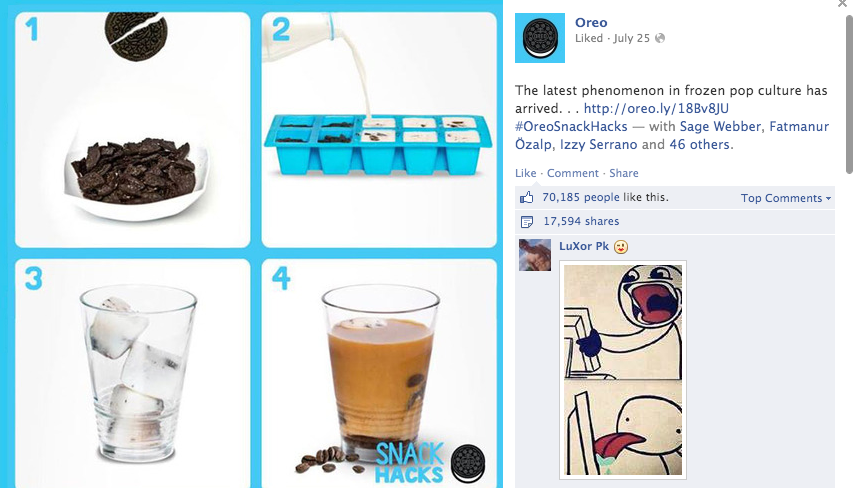
W) Word of Mouth
A viral marketing campaign must have an inherent feature that gets people talking, because once they do that, they will do most of your advertising for you – via word of mouth.
Besides making it easy for people to share your content (like social sharing buttons on your website), one of the best ways to get people to share your brand’s content is to encourage them to create content for you, which is called user-generated content.
Fabio Wibmer won the GoPro World Challenge in November for this amazing user-generated video, which got over 33 million views on YouTube:
Dive Deeper: Word-of-Mouth Marketing — What Is It and How Do You Do It?
X) Xenial
A viral campaign message must be friendly, which is the definition of “xenial” (hey, it’s hard to come up with words that start with X!). Your content should be something that the audience can easily relate to and connect with. Viral campaigns appeal to the masses and that’s the reason they go viral.
Y) Youthful
No matter who you’re targeting with your products and services, your viral campaign must appeal to the youth. Not only was everyone young at one point so they should be able to relate to your message, but today the younger generations are more likely to appreciate authentic, socially responsible content – and share it.
Take a look at this viral video from Always. The women’s brand created the #LikeAGirl campaign to support and empower young girls, and the campaign was an instant hit with 67.6 million views and 289K likes:
Z) Zesty
Have you heard of a viral campaign that’s dull and boring? Of course not. A viral campaign should be bustling with power and energy. It must be full of vibrancy that hits the audience the moment they see or hear it. Make your content the talk of the town by making it punchy, emotional and hard-hitting.
Over to You
You can’t possibly produce a viral campaign every week or month, but you can certainly try hitting the jackpot once every quarter, six months or year.
When your efforts are persistent, your idea is creative and your message is genuine, you’re bound to get good or great results. After that, the success is up to the people. If you can make something unique and worthwhile, viral marketing is a great way to get quick visibility for your brand. If done right, it can surely fetch you some great rewards for your business!
The A-Z of Viral Marketing infographic from Digital Vidya:

